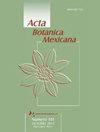标题墨西哥嗜苔藓真菌Paruephaedria heimerlii (Dactylosporaceae,子囊菌科)的首次记录
IF 0.8
4区 生物学
Q4 PLANT SCIENCES
引用次数: 2
摘要
背景与目的:丝状真菌是一种与苔藓植物种类、属或科相关的多种多样的共生蘑菇。Paruephaedria heimerlii在Jungermanniales中是一个具有苔藓习性的物种;它在阿拉斯加、欧洲、日本和塔斯马尼亚岛都很有名。因此,这项工作的目的是在墨西哥首次记录该物种,这是其已知的第一个热带地区。方法:在墨西哥韦拉克鲁斯州松栎林和热带云雾林植被中采集标本。该材料经草药处理并经冷却去污,然后从子囊瘤的组织学切片上测定,并用光学显微镜观察。最后,这些材料被保存在国立政治学院(Instituto politcnico Nacional)的植物标本室ENCB和Veracruzana大学Biología学院XALU的真菌收藏中。主要结果:利用孢子、子囊和膜结构等性结构的形态特征和测量,确定该材料为Paruephaedria heimerlii,这是该物种在墨西哥和热带地区的首次记录。结论:根据我们的观察和与文献报道的比较,海默氏斑蝽的存在可能不受其栖息地的温度或海拔的限制,而取决于宿主的可获得性。本文章由计算机程序翻译,如有差异,请以英文原文为准。
First record of the bryophilous fungi Paruephaedria heimerlii (Dactylosporaceae, Ascomycota) for Mexico
Background and Aims: The briofilous fungi are a diverse and polyphyletic group of symbiotic mushrooms associated specifically with few bryophyte species, genera or families. Paruephaedria heimerlii stands out as a species with a bryophilous habit in Jungermanniales; it is known from Alaska, Europe, Japan and Tasmania. Therefore, the objective of this work is to present the first record of this species in Mexico, its first known tropical locality.Methods: The studied specimens were collected in the vegetation of pine-oak forest and tropical cloud forest in the state of Veracruz, Mexico. The material was herborized and decontaminated by cooling, followed by determination from histological sections of the ascomas and observed with an optical microscope. Finally, the material was deposited in the fungal collections of the herbaria ENCB of the Instituto Politécnico Nacional and XALU of the Facultad de Biología of the Universidad Veracruzana.Key results: Using morphological characteristics and measures of sexual structures like spores, asci and hymenial structures, the studied material was determined as Paruephaedria heimerlii, representing the first record of this species both in Mexico and for the tropics. Conclusions: According to our observations and comparisons with reports in literature, it is probable that the presence of P. heimerlii is not conditioned to the temperature or altitude of the habitat in which it is found, but to the availability of hosts.
求助全文
通过发布文献求助,成功后即可免费获取论文全文。
去求助
来源期刊

Acta Botanica Mexicana
生物-植物科学
CiteScore
1.60
自引率
12.50%
发文量
52
审稿时长
>12 weeks
期刊介绍:
Acta Botanica Mexicana da a conocer trabajos originales e inéditos en todas las áreas de la botánica, incluyendo florística, taxonomía, taxones nuevos para la ciencia, ecología, etnobotánica, paleontología, evolución, conservación, etc. Está dirigida a botánicos mexicanos y extranjeros que aporten información en estas áreas del conocimiento, particularmente con plantas nativas del continente americano. Hasta 2018 apareció cuatro veces al año con una periodicidad estricta en la primera semana de enero, abril, julio y octubre; a partir de 2019 se publica de manera continua, sin periodicidad preestablecida, en formato electrónico y de forma gratuita.
 求助内容:
求助内容: 应助结果提醒方式:
应助结果提醒方式:


